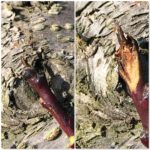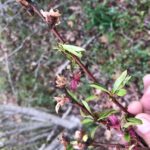Tree Fruit Phenology:
Tree fruit phenology is advanced based on historical observations. In southern counties some early blooming varieties are at pink to about 20% bloom. Redhaven was at bud swell on March 20, about 3 days earlier than the median observation date. Red Delicious was at 1/4″ green tip on March 21, about 10 days earlier than the median observation date. Plums are in bloom and Pears are at green cluster.
Peach:
Brown Rot: Blossom infections from the brown rot fungus can occur whenever pistils are exposed and a favorable climate exists. Infections can occur during any wetting period when temperatures are between 41 and 86 °F. However, optimum conditions for infection occur with wetting and temperatures in the mid 70’s. During long wetting periods (several days or more) blossoms can be infected regardless of temperature. Generally infections that occur when conditions are sub optimal are less severe. Blossoms and fruitlets will remain susceptible until the pistil dessicates (sometime between petal fall and shuck split). Initiate coverage for blossom blight starting at pink for short petaled varieties and 5-10% bloom for showy flowers. See the NJ Commercial Tree Fruit Production Guide for recommended materials and rates.
Bloom Cankers: Bacterial Spot is a key pest of Peach, Nectarine and Plum and in some years like 2019 can cause significant losses. It is caused by the bacterium Xanthomonas arbicola pv. pruni. Bacterial spot cankers that cause tip dieback (commonly called Black Tip) are often difficult to distinguish from cankers caused by other peach diseases. Other cankers that may appear during bloom are caused by the blossom blight phase of brown rot, and constriction canker. Black tip usually appears during or just after bloom. Typical symptoms are a gradual blackening of the tip with dead tissue moving down the twig and is often observed on highly susceptible cultivars (Fig. 1). Tip die back may also occur from abiotic factors such as frost. Tip die back from frost is often accompanied by blind wood usually 6-8 inches below the tip where leaves and flowers have fallen off after being killed by a freeze.
In some cases the twig may appear healthy and a shoot begins growing from the tip only to die back after leafing out and flowering. This is often a symptom of late winter/early spring infections of constriction canker. Many times a bud that was infected in the fall and never leafed out may be found just below the new shoot that is dying. This usually a good clue that constriction canker is the cause. These symptoms may be more prevalent in old trees that have a history of the disease (Fig. 2).
Tip cankers such as these may be accompanied by cankers on flower buds lower down the on the twig typically associated with blossom blight or constriction canker, or they may appear alone. Spring cankers from bacterial spot that form around flower buds are less commonly seen in our region. In cases like this it is difficult to diagnose the disease early on, especially where symptoms are randomly found at low levels or are mixed in appearance. The only thing that can be done is to note the trouble blocks and watch to see what develops. Blossom blight and constriction canker will eventually develop unique symptoms. Bacterial spot lesions will eventually show on the leaves. If you see black tip cankers forming during bloom its not a bad idea to assume its bacterial spot and start antibiotic treatments as soon as is practicable, and to continue to monitor to see if leaf lesions develop.
Oriental Fruit Moth: A biofix point for OFM has not yet been set. The first insecticides for first generation Oriental Fruit Moth control should be applied at 170-200 degree days after biofix. This timing generally coincides with petal fall in peaches.
Green Peach Aphid: GPA colonies begin forming sometime during bloom. Examine trees for the presence of colonies from pink to shuck split. Count the number of colonies on ten trees and use a treatment threshold of 2 colonies/tree at petal fall for peach, and 1 colony/tree for nectarine. The best way to scout for aphids during bloom is with a beating tray. Blossoms may also be collected, opened, and examined for the presence of aphids using a hand lens. See the NJ Commercial Tree Fruit Production Guide for recommended materials and rates.
Tarnished Plant Bugs and Other Catfacing Insects: Catfacing insects are starting activity but cause little damage at this time of the year. Catfacing insects will become more of an issue as temperatures warm and mowing and other ground cover activities become more common after bloom. Insecticides for catfacing insects are not recommended until after all petals are off.
Apple:
Diseases: Apple Scab and Fire blight are the main targets at this stage. The NEWA scab models are estimating about 3% ascospore maturity during this period in southern NJ. Northern counties will have less ascospore maturity. Copper formulations applied for fire blight suppression should be adequate for scab control at green tip to 1/4″ green, unless scab was not controlled in 2021. If your orchard had scab last year, include a protectant such as vangard or syllit at green tip. Copper should not be applied after 1/4″ green where fruit russet is a concern. Beginning at 1/2″ green highly effective scab materials should be used. Primary apple scab spores are released during any substantial infection period. At tight cluster include products effective for powdery mildew and cedar apple rust. More information can be found in this 2020 blogpost from Penn State.
Scale and Rosy Apple Aphid: One sees many recommendations for mixing materials efficacious for scale such as Lorsban (chlorpyrifos) or insect growth regulators (Centaur; Esteem) with delayed dormant oil applications. As of February 28, 2022, Chlorpyrifos formulations no longer have a food tolerance and should not be used. The general consensus from data review seems to be that the addition of scale insecticides to oil do not significantly improve control over oil applied alone, however some of the newer products are compatible with oil and have efficacy on their own when applied at the delayed dormant stage of growth. Recent tests performed by Dr. Neilsen’s lab indicate that both Sivanto Prime and Centaur when applied alone in the pre-bloom period are comparable to dormant oil for scale control. Venerate also has a good rating but may need more than one application. Esteem has good efficacy for scale when applied up to to 1/2″ green. Closer has some efficacy against scale, however it has not been evaluated for control of overwintering scale. Esteem, Closer, Sivanto Prime, and a new product: Versys, applied either alone or with oil at 1/4″ to 1/2″ green all have good to excellent ratings for rosy apple aphids. See the NJ Commercial Tree Fruit Production Guide for more information.
European Red Mite; San Jose Scale: Oil applications for mite suppression and scale control should start at 1/4” green. Apply 2% dilute or 4-6 gals oil/acre concentrate at 1/4”green to tight cluster; 1% dilute or 2-3 gals/acre concentrate at tight cluster to pink. Oil should not be applied if temperatures are expected to dip into the mid 30’s within 48 hours of application, and captan or sulfur should not be applied within 14 days of any applications of oil or oil based formulations. Check the product labels for additional phytoxicity precautions.
Pear:
Pear Psylla: Dormant oil applications should have already been started to deter psylla egg laying. At the green cluster stage a pyrethroid is generally included with oil to knock down adults migrating into the orchard. In lieu of oil, Surround may also be applied starting at swollen bud and continued through bloom. If using Esteem for psylla control make one application delayed dormant through popcorn or two applications; one at delayed dormant through popcorn and one at petal fall. Centaur is also effective and one application may be made pre-bloom or at petal fall. Sivanto Prime is also labeled for early season applications and should be combined with oil.
Pear Diseases: It’s not too late to apply copper for fire blight suppression unless fruit russet is a concern. Include effective materials such as Ziram or EBDC formulations for Pear Scab and beginning at the cluster bud stage. At white bud use products effective for pear scab and fabrea leaf spot. Start planning for blossom sprays using antibiotics. For both apples and pears, consider using Kasumin at bloom. Kasumin is an antibiotic like Streptomycin and Oxytetratracycline. It contains Kasugamycin which is a different chemistry. Kasumin is only labeled for bloom and petal fall applications while strep and oxytet are labeled for post bloom use. Using 3 different chemistries in rotation allows for resistance management while extending the protection into the post bloom period when late blossoms typically appear. which ever material you use, the addition of Actigard or other plant defense elicitors may improve control.



